Do-it-yourself well in the country: a review of technology and tools for manual drilling
A well in a summer cottage will save a lot of problems. Provides water for irrigation, caring for personal vehicles and territory. It is unlikely that water produced by hand will be useful for drinking purposes, but it is quite suitable for hygiene procedures.
True, drilling production is not too cheap. Another thing is if a well is built in the country at home. In this case, you can acquire your own source of water with minimal financial loss. Do you agree?
In our article, we describe in detail the drilling technologies available to independent drillers. The drilling tool and the rules for selecting it depending on the physical and mechanical properties of the soil are described in detail. Our recommendations will provide effective assistance in the construction of water intake.
The content of the article:
Short simplified hydrogeology course
Groundwater differs significantly from surface analogues. They do not flow in the form of stormy streams with rivers, do not gather in lakes, unless they come across a karst cavity in the earth's crust.
If zealous streams frolic under our feet everywhere, cities and settlements would collapse after the ground, which did not have a reliable rock base.
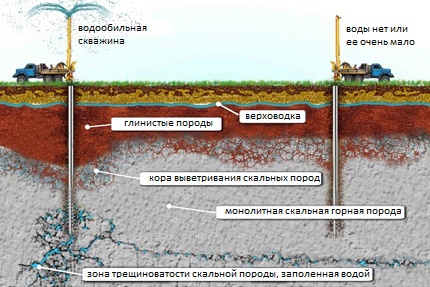
The nature of the occurrence of water in the rocks
Underground water contains pores, voids, and cracks formed in rocks during various geological processes. We will not go into the genesis and principle of the processes in this article.
We only note that their physical and mechanical properties, as well as the hydraulic engineering and hydrogeological specificity of the water contained in them, depend on the method of soil formation.
Groundwater is characterized by some movement within the enclosing layer - the sediment layer with equivalent properties and structure.By analogy with surface ones, they are affected by gravity, causing current to the lower layers or along the slope to the underlying areas.
If the underground water has the opportunity to accumulate, but there are no ways for unloading, then the pressure rises. Water due to physical features cannot be compressed. Within a confined space, pressure causes the fluid to seek a place for natural release. Thanks to this phenomenon, springs come to the surface and geysers beat.
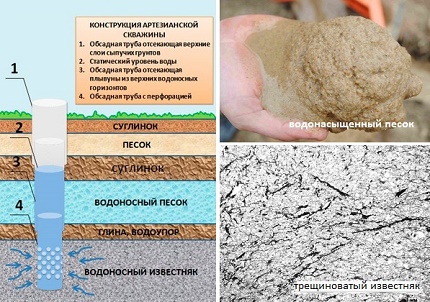
Soils, pores, cavities and cracks which contain water are called water-bearing or aquifers. The production constructed for water intake should be buried in them. Among the aquifers there are species that can freely pass water through themselves, and species that can only hold.
In the geological section, water-carriers usually alternate with water-holdings. These are clay soils, the structure of which is similar to all known clay, do not contain water and do not pass it.
Water can be in small lenses and cracks formed in loams and solid sandy loams. However, most often it is simply absorbed by clay deposits, thereby changing their texture.
Rock and semi-rock varieties in an undisturbed state also belong to water storage areas, i.e. no cracks. If their body is dotted with cracks of various caliber, and even filled with water, then rocky and semi-rock formations pass into the category of water-bearing.
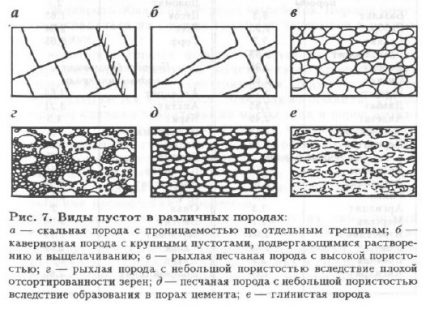
Groundwater classification
The nature of the formation of water-containing soils underlies the classification according to physical and mechanical qualities.
According to what, groundwater suitable for use is divided into:
- Water sedimentary deposits. They are located in the sand pores of various sizes, in the voids of gravel, pebble, crushed stone deposits. They contain clastic soil, particles of which are not connected in any way. The indicated rocks have excellent filtration qualities: water in them and through them can freely move in a direction convenient for it.
- Water of bedrock. They are found in fissures of rocky, semi-rocky, and a number of sedimentary cemented soils. The most common containing representative is limestone. Water can spread along the cracks of hard clay, marls, sandstones, etc., but these options are unsuitable for production.
The filtration properties of bedrock depend on the degree of fracture. In the undestructed state, their particles are fixed by crystalline or consolidated bonds that do not allow water to flow within the layer, seep out and penetrate from the outside.
Water in bedrocks is formed due to condensation. Accumulating for centuries, not receiving external recharge. Naturally, in a limited space it is crowded, because of which, when opening such a layer, the static level is usually set above the depth. Sometimes such wells even gush out.
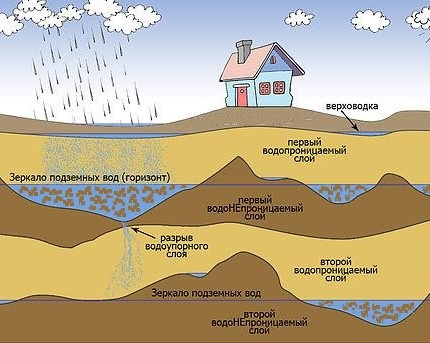
Sediment is regularly fed by atmospheric water. It penetrates by banal seepage - infiltration through the layers lying above. Sedimentary water carriers can be saturated in the horizontal direction, for example, receiving water through the same infiltration from a nearby reservoir.
The filtration properties and the nature of the formation of rocks is closely related to the hydraulic qualities of the water contained in them.
According to the indicated feature, groundwater is divided into the following categories:
- Pressureless. These are waters occurring in sedimentary rocks, first from the surface of water-permeable formations. They are freely fed and unloaded in the same way into water bodies or underlying layers, therefore they differ in zero pressure.
- Pressure or artesian. It is clear that for the most part these are bedrock waters. However, they include some wells that open the sedimentary aquifer. For example, if the site is in a decay between two hills, the water uncovered by the mine will tend to reach an average level in the formation and gush.
If the aquifer confined to sedimentary rocks lies between the water-resistant layers of the same genesis, then they can be characterized by a slight pressure. A vivid example: sand saturated with water, “covered” by loam layers above and below. At autopsy, the static level for some time may be slightly higher than the roof of the layer itself.
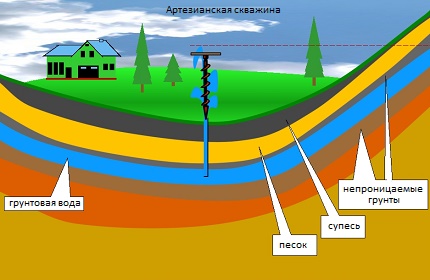
People call such water interstratum, among hydrogeologists of low pressure. In practice, such situations are extremely rare. Because water, confined to sedimentary soils, there is almost always an opportunity for unloading.
This possibility may turn out to be 1-10 km or more from the drilling point, but thanks to it there is no pressure in the water-carrier. Hence, there can be no talk of pressure.
Drillability category as an argument
In addition to the listed classification differences, there is still a very important sign that masters who want to drill an aquifer in their own cottage need to familiarize themselves with. This is a drillability category that significantly limits the range of manual drilling capabilities.
The category of drillability is again determined by the physical and mechanical qualities of the rocks and the specificity of their origin. According to these signs, the soils are divided into:
- Loose. Large and small clastic sedimentary rocks that do not retain their form during development: sands of all degrees of density and grain size, gravel, gravel, pebble deposits. Easily destroyed, but not always easily removed from the well.
- Plastic. Clay sedimentary soils that retain their shape when developing workings: this is a family of loam, clay and sandy loam. Destroy more difficult than the previous type, but are extracted due to its own "stickiness" without any problems.
- Solid. These include rocky and semi-rocky rocks. The highest category of drillability, confirming the complexity and complexity of development. The rocks are difficult to destroy, from the bottom to raise them is also not easy.
Sedimentary deposits are represented by loose and plastic varieties. Their drilling can be handled on their own. There is no particular need to employ machinery and produce super-sophisticated drilling tools.


Indigenous are mainly rocky and semi-rocky species of rocks. For an independent driller, this is an almost inaccessible option.
It is too difficult to develop without drilling rigs, and without a specialized destructive tool, chisel, it is generally impossible. Hard and semi-hard clays are drilled easier than “rocks”, but they do not pump water from them.

Note that drinking water is produced both from sedimentary deposits and from bedrock. However, the variety associated with "precipitation" is often only technical because of the ability of soils to pass any liquids, including effluents, spilled oils, oil products, etc.
In any case, the water pumped out from a personal source must be brought to the SES for verification in order to obtain a verdict on drinking or technical equipment that is substantiated by analysis.
Selection of a place for a well in a summer cottage
Before making a well for water intake in the country, it is necessary to conduct independent hydrogeological surveys. It sounds loud, but they consist in an elementary survey of neighbors who have their own source of water.
Find out during the survey you need:
- Depth of water mirror at existing points of withdrawal. You can find out this circumstance from the owners of both wells and wells.
- Static Level Stability. Does it have the property to fall significantly in the dry summer period and in winter.
- Geological situation. More precisely, what rocks were discovered when digging a well or drilling? Have boulders met?
Dacha plots, as a rule, are located in a flat area, which is characterized by an almost horizontal occurrence of geological elements. Slight deviations will only be due to the difference in absolute marks between the existing source and the drilling point.
It is better not to use any popular methods for searching for signs of water on a site. Talking about the sensitivity of ants and taking into account the climate is generally ridiculous; they do not in any way affect the occurrence of groundwater. It was necessary to be guided by a climate generally when choosing a site.
It is very worthwhile to decide on the shortest route from the source to the house or to the bathhouse. And be sure to take the opportunity to install the tower with the convenience of carrying out the whole complex of works. Determine the best time for drilling will help next article.
Rent a mobile drilling rig
The simplest and least time-consuming method of constructing a well in its own country house is to rent a mobile drilling rig. With its help, you can drill and equip a one-man construction for water intake in a couple of days.
The installation will effortlessly pass through the thickness of sedimentary soils and, if desired, the wizard will open the indigenous ones, but this method cannot be called cheap.
Drilling tools will be needed to drill the water intake. To extract loose rocks, you need a bellow, clay soils are easier to lift with a screw, glass or core pipe. If there is a destruction of boulders or rock, you need to stock up on chisels.
As a more affordable alternative, a collapsible manual drilling device is suitable. It includes a screw with a handle for rotational movement during drilling and a set of rods for building the drill string. "Handbrake" calmly drill wells 10-25 m. It is possible and deeper, if health and the number of bars allow.
For lack of a drilling rig or a factory-made device, they resort to methods that were recently used in professional drilling. We will talk about shock-rotational and shock-rope manual method.
Due to the heterogeneity of the geological section, drilling methods are most often used in combination. The difference in the rock destruction and extraction technique allows literally any geological formations to pass through.
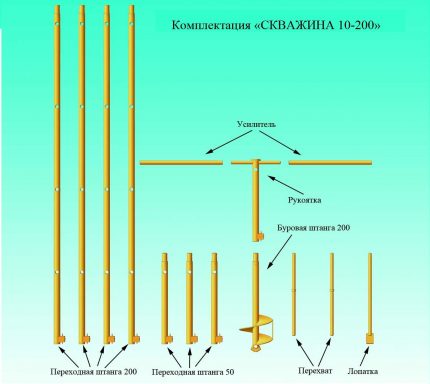
Manual Drilling Methods
Before deciding to implement a do-it-yourself water intake device project, you should carefully familiarize yourself with the methods of drilling holes. The technology is selected depending on the geological structure of the site. To do this, they ask neighbors with partiality how they dug a well or drilled a well from them.
Having found out what type of soil had to be previously excavated, they are determined with a drilling tool. It will need to be made by ourselves or rented. Immediately you need to decide what to do with oil rig: borrow from someone for temporary use or build yourself.
Option # 1 - rotational percussion drilling
From the name it is clear that the destruction and extraction of dumped rock from the trunk is carried out by impacts and rotations.
To carry out these drilling operations, different types of shells are used, these are:
- The spoon. Designed for rotary drilling, used in tunneling on plastic soils. It is a cylinder devoid of less than half or only a segment. The drill is made with some displacement of the central axis so that the hole is drilled wider than the tool itself.
- A drill, otherwise auger. Designed for the development of dense clay soils by the rotational method.It is a screw with one or more turns. It acts elementarily: it is screwed into the ground and on the blades carries the destroyed mass to the surface.
- Bailer. Designed for the development of loose sedimentary rocks by impact method. In addition to it, not a single tool is suitable for the full extraction of gravel-pebble deposits, gravel, pebbles, loose sand. The flap is indispensable in lifting saturated with water, which is why very heavy soils.
- Bit. Designed for crushing hard rocks by repeated persistent blows. It is used in tandem with the choke, which, after destruction, scoops the dump from the bottom.
Spoon - a universal drill, with two exciting devices. To cut and grab the soil vertically, the left wall of the original opening in the cylinder is slightly bent.
For the lower grip, a cutter in the form of a bucket on the sole of the drill is most often arranged. Variations on the theme of a spoon are a huge number. Those who want to make it with their own hands need only deal with the principle of action.
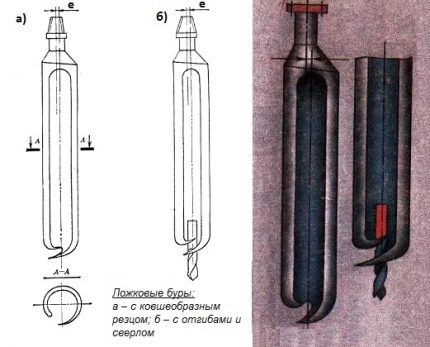
Like a screw, a spoon is screwed into the rock. With the lower incisor, it crashes into the soil, which after separation from the array falls into the incomplete cylinder. A side cutter spoon during rotation cuts off the rock from the walls of the barrel. The newly cut soil compacts the previous portion and pushes it into the cavity of the projectile.
Work is carried out until they fill the cavity of the spoon with a blade half or 2/3. Then the drill is removed from the well and freed from the drilled blade through the vertical side opening in the cylinder. The empty shell is again lowered to the bottom and then drilled.
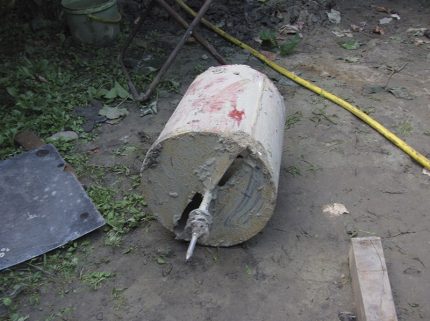

The axis of symmetry of the spoon is shifted for a reason. The eccentric allows you to drill a hole suitable for simultaneous installation casing pipe. Casing is necessary for the formation of the trunk in sedimentary sediments.
Without it, loose rocks will endlessly crumble to the bottom of the well, and when wet, clay will “bulge” into the trunk, narrowing the clearance and making it difficult to deliver the projectile to the face.
Recently, a variety of screw modifications have been actively crowding out a spoon. They really facilitate the penetration, but by the standards of extraction of the destroyed rock they are significantly inferior to the spoon.
It can be drilled wet sticky sands, and the auger does not completely lift them. To clean the face after the screw, you almost always have to use a bailer. It turns out that the work is carried out in double volume.
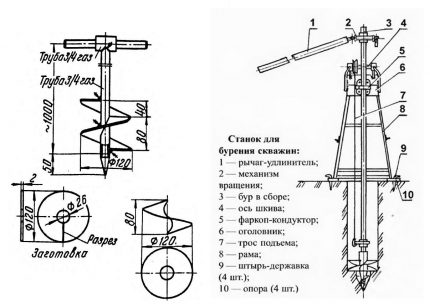
The simplest model of the choke is made from a pipe segment Ø 180-220 mm, depending on the size of the well. Do not forget that for pumping water with a submersible pump, the internal casing Ø should be 2-3 cm larger than the external pump Ø. Otherwise, it will not be possible to lower it into the water intake structure.
The optimum length of the pipe section for the choke is 1.0 - 1.2 m, so as not to suffer from lifting, emptying the projectile and cleaning it from the inside easily with your hand if necessary. In the upper third, the window required to extract the drilled soil is cut out. Put it on the top of the head with bolts or weld an earring to which the cable will be attached.
The tool shoe is most often equipped with a one-, rarely a two-way valve. In narrow bouts, the ball serves as a valve. In order for the lower part to loosen better and crush the rock, sharpen a sharp edge or cut down the teeth along the bottom.
Some interesting options making the bobbin are given in the article, which we advise you to read.
The choke held by the cable is freely thrown into the face. Upon impact on the ground, the valve opens, and the destroyed soil moves into the cavity of the pipe.
Having passed a portion of soil into the cavity of the projectile, the valve closes, so that the bailer retains loose loose material. Then the projectile is lifted above the face to a height of 1.5 - 1.0 m and is thrown again until the next 0.3 - 0.4 m is passed.
About, how to make a drill for manual drilling of water wells, described in detail in our recommended article.
We present proven bit designs, but we sincerely wish not to be confronted with the need to use them. Of course, it is impossible to destroy the “rock” manually without a chisel. But is it worth it to mess with?
Drilling will take place literally a couple of cm per day. It is wiser to use a mechanized method: rent a mobile installation or invite drillers.
A bit may be needed if large pebbles and boulders are found in the sedimentary section. It is impossible to imagine where it is possible to stumble upon them in reality, because they have a chaotic location.
If the boulder meets after two / three meters of penetration, it is better to change the location of the well. If about 15 - 20 m is drilled, it is better to crumple, for a long time and persistently dropping the chisel onto the stone.

During drilling, all of the above tools periodically add water to the well. It performs the function of drilling fluid, temporarily binds loose soils, softens clay rocks and cools the tool, protecting it from premature wear.
For the manufacture of drill rods, pipes marked with VGP are ideally suited, the inner diameter of which varies in the range 33 - 48 mm. The length of the rod must be selected based on the height of the tower. So that when lifting in the lumen between the block and the day surface, 2-3 links are freely placed.
The traditional length of the rod is 1.2-1.5 m, but it happens that they are also made at 5.0 m. Of course, when a drill string is made of long elements, there are fewer joints. Therefore, there is less possibility of breaking the pipe chain in the barrel.
However, it is quite difficult to extract long rods from a mine. Moreover, it should be remembered that the top of the column almost reaches the block with a cable thrown over it, and usually a part of the casing sticks out from the well below.
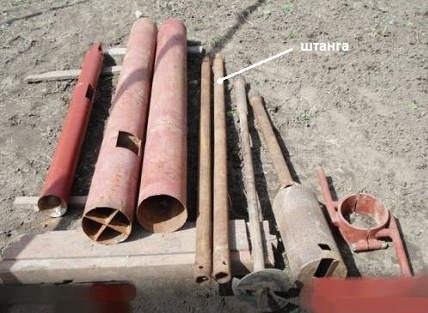
The rods are connected by threaded couplings or metal “fingers” - pieces of bar made strictly according to the Ø holes in the rods intended for joining. The start link is equipped with an earring for attaching a rope.
The lower part of each link should seamlessly connect to the next element and be structurally identical to the device on the top of the spoon or screw.
Option # 2 - Shock Rope Drilling
Drilling by turning deeper than 10 - 15 m becomes too heavy, because in addition to a loaded projectile, which has considerable weight, it is necessary to get a drill string from the workout. In addition, each time you climb, all these meters must be constantly disassembled and then reassembled to deliver the tool to the face.
In mechanized drilling, everything is simpler - hydraulics make rotation, delivery and extraction of the tool. To do such a job manually is impractical and too difficult.
In addition, when performing rotational movements without using mechanisms, you can easily deviate from the vertical. And the greater the depth, the greater will be the skew, which makes it difficult to deliver the drill to the bottom, and the installation of casing, and the installation of the pump in the well subsequently.
With manual drilling at such a depth, it is more reasonable to resort to shock-rope technology. In principle, it has already been stated by us as part of the description of the work of the chipper. This is a standard projectile for percussion drilling.
For driving through clay soils, a conical beaker with a cutting edge at the bottom of the shoe is used. Unlike the bailer, the glass does not have a valve and a window for excavation.
It is also thrown to the bottom of the well with effort and removed as it is filled. On impact, clay is pushed into its cavity, held only by the walls and its own ability to stick.
The glass is freed from the blade by tapping a sledgehammer on its walls. The sticky rock is then separated from the inner surface of the projectile and falls out. No drill rods needed for glass drilling.
This means that you do not need to constantly disassemble and reassemble a considerable “chain” of drill rods. True, one or two of them can be used to banally weight the instrument when lowering it to a considerable depth.
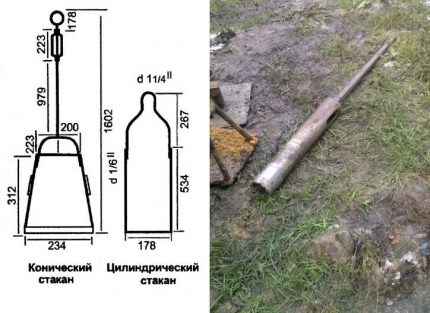
To perform rock blows, a cable or rope is attached to the drilling tool, on the basis of which the drilling method is called shock-rope. To perform rotational movements, a drill rod string is used that connects the drill with a manual or mechanical collar.
To increase penetration during rotation drilling, the projectile also hits the face, and in order to strengthen the fracture force, the drill shoes are equipped with all kinds of cutting parts.
It is clear that during drilling, the drill must be regularly lowered to the bottom, and after filling it must be removed to the surface. Do not forget that with increasing depth it will be harder to get a tool with developed soil with each penetration. To facilitate drilling using the described methods and tools, a homemade drilling rig will help.
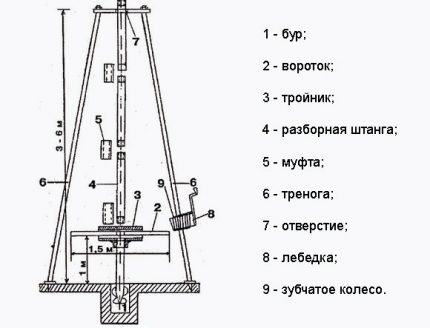
The classic version of the derrick is made in the form of a tripod with a total height of about 4.5 - 5.0 m. A block is installed in the upper part of the derrick through which the cable connected to the projectile is thrown. During rotary drilling, the tower is needed in order to raise the drill string, consisting of a tool and drill rods.
When drilling a hole with a depth of 10 - 12 m, you can do without a drilling rig, but more muscle work will be required. So it's better after all with her.
If you are completely reluctant to get involved with its construction, a device in the form of two columns with a crossbar and a lever thrown over it will do. It is possible that, based on the proposed designs, you can develop your own device that facilitates the work of the driller.
Downhole bore
For casing a borehole, the best option is steel pipes. Polymer will come together, but in terms of strength when buried in the ground, they are not too good. Again, not hydraulics will push the casing into the well, but manual efforts, and light plastic pipes into manual production will not be easy to deepen.
The casing is assembled from individual links, about 2 m long. It is possible and more, but it will be inconvenient to install them in the trunk during drilling. Therefore, although there will be many connections in the casing, it is better to use a suitable size for work.
The first link is installed after two / three walkers. Then it is gradually squeezed, laying a bar on top to apply its own strength and weight. When drilling by the rotary method, the deepening of the casing is carried out after the extraction of the tool with soil.
The use of the shock-rope method in loose rocks forces to deepen the casing with a certain lead of the projectile, otherwise the drill will infinitely scoop the layer without moving down.
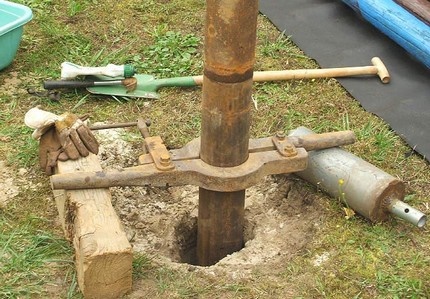
Casing links are connected by welding or threaded couplings, but it is best to initially select threaded pipes. As they are deepened, it is easier and more convenient to screw them on than to constantly cook and check the joint for defects.
They continue to drill until they pass through the aquifer and penetrate into the underlying confinement by at least 0.5 m. After that, the casing string is “pulled” slightly to the surface in order to exit the water-resistant layer. Then produce pumping water intaketo get rid of the rock destroyed during the drilling process.
Upon completion of the flushing, another pipe string with downhole filterwhich will save water from pollution and protect the pump. Now you can install a pump, the type of which is selected depending on the depth of the aquifer.
The final stage of organizing your own water source is the arrangement of its mouth. For this build a caisson or put the tip purchased at the store.
Conclusions and useful video on the topic
Video # 1. Demonstration of a homemade drilling rig:
Video # 2. Testing a homemade auger drilling machine:
Video # 3. Hydro-drilling principle based on auger well development:
The methods of manual drilling that we have presented will help in the difficult but useful business of developing your own source of water in a summer cottage.
We invite those who wish to share their own experience in well drilling to leave comments in the block below. Ask questions, talk about useful nuances in the business of driving and arranging water intake workings, post a photo. We are interested in your opinion on the information provided for familiarization.

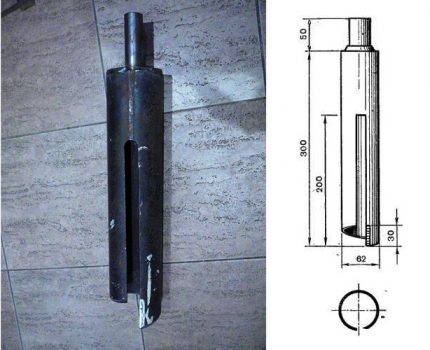
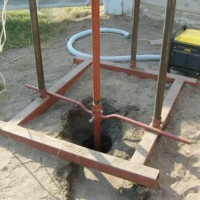 DIY water well: arrangement rules + analysis of 4 popular drilling methods
DIY water well: arrangement rules + analysis of 4 popular drilling methods 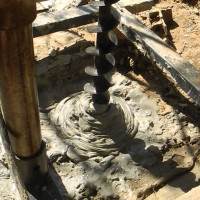 Do-it-yourself well without equipment: how to independently arrange a water source
Do-it-yourself well without equipment: how to independently arrange a water source 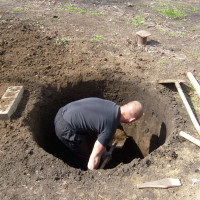 Digging a well with your own hands: types of well structures + an overview of the best digging technologies
Digging a well with your own hands: types of well structures + an overview of the best digging technologies  DIY drilling rig: making a homemade drill for drilling wells
DIY drilling rig: making a homemade drill for drilling wells 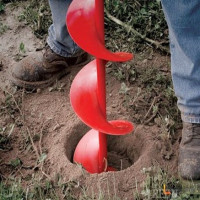 How to drill a well with your own hands: ways to budget independent drilling
How to drill a well with your own hands: ways to budget independent drilling  Do-it-yourself flushing of the well after drilling: step-by-step briefing on the work
Do-it-yourself flushing of the well after drilling: step-by-step briefing on the work  How much does it cost to connect gas to a private house: the price of organizing gas supply
How much does it cost to connect gas to a private house: the price of organizing gas supply  The best washing machines with dryer: model rating and customer tips
The best washing machines with dryer: model rating and customer tips  What is the color temperature of light and the nuances of choosing the temperature of the lamps to suit your needs
What is the color temperature of light and the nuances of choosing the temperature of the lamps to suit your needs  Replacement of a geyser in an apartment: replacement paperwork + basic norms and requirements
Replacement of a geyser in an apartment: replacement paperwork + basic norms and requirements
I didn’t find a place on a summer cottage where it is guaranteed to have water and where you can drill, I invited a specialist.It was unrealistic to rent a drilling rig, so I took a manual drilling device from my friends. Two friends helped. Over the weekend, 10 m passed. We used rotational percussion drilling (we had sand in the country, so the bit was not needed). We got to the water successfully.
Honestly, I can’t even imagine how to drill a well myself. He set the fence, drilled holes under the posts. Out of breath. And if there is no rig nearby, and it needs to be done? In general, I do not see the point in all of this. Yes, it will probably be cheaper, perhaps much cheaper. But labor costs did not stand nearby either. It is a pity, the cost of third-party drilling is not given, and the cost of manufacturing such a thing. It would be interesting.
I understand you perfectly, if there is no experience in this direction, and water is urgently needed on a site or in a country house, then such experiments should not be started. Yes, the article highlights very different subtleties, but without experience when drilling a well, a beginner will immediately be at a standstill several things: quicksand, boulder, hard rock.
Using the manual for self-drilling of a well will be relevant for people whose homes are far removed from city or district centers or if local specialists inflate prices for their services. And, of course, enthusiasts who have a lot of free time and lots of diverse tools - such people like to challenge complex projects.
For an ordinary resident of a private house, it’s easier to order a well drilling service than to do it yourself, make mistakes and ultimately entrust the drilling to professionals anyway.